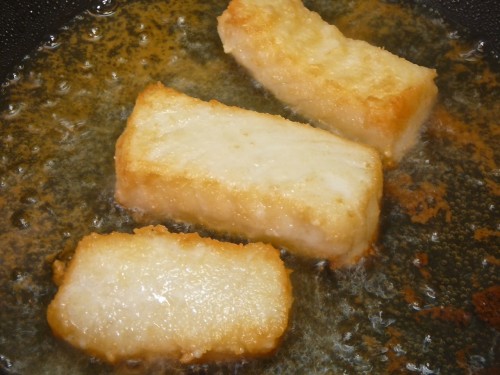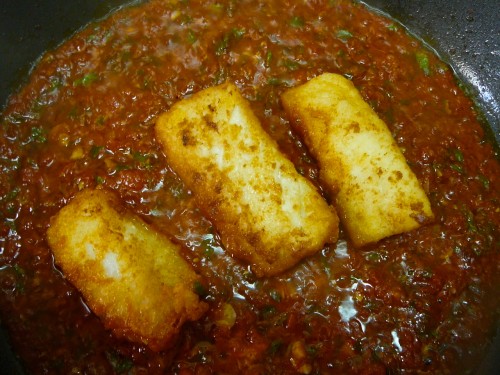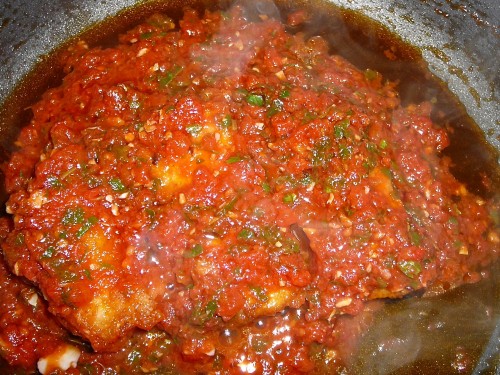In the U.S. you can count on finding a burger at every truck stop, small town or major city. In the U.K. the same could be said about fish and chips. In Italy, it’s baccalà (salt cod). In the case of hamburgers or fish and chips, the recipe never varies much, but the recipe for salt cod changes drastically from region to region in Italy. Don’t ask for baccalà alla Livornese in Venice or baccalà mantecato in Puglia.

It’s not hard to imagine why salt cod became the go-to food around the Italian boot. In times before trucks and refrigeration, the transport of fresh fish was impossible. Despite this fact, the Roman Catholic Church mandated days of abstinence when meat could not be eaten. Salted or dried fish became a Friday and Lenten favorite. It had the added benefit of being very inexpensive and was a protein staple for the poor. Cod boasts remarkable nutritional properties: it contains over 18% protein, which once dried rises to almost 80%.
Salt cod came to the ports of Livorno, Genoa and Naples in the 11th century, brought by Basque sailors, who ventured into the waters of the northern Atlantic, hunting the whales that passed through the Bay of Biscay. They came into contact with the Viking sailors, who dried the fresh-caught cod in the cold dry North Sea winds and then broke it into pieces and chewed it like a biscuit. In the 13th century, the Portuguese, realizing the commercial value of the easily-stored dried fish, cornered the market, sending their ships as far as Greenland. They added salt to dry the fish faster, giving rise to bacalhau (derived from the Latin, meaning “baculus” or stick). They traded salt cod along the western coast of the Italian peninsula.

The history of baccalà in Venice only dates back to 1431 when a Venetian ship, laden with spices and 800 barrels of Malvasia wine, departed from the island of Crete under the command of the sea captain Piero Querini, and headed for the North Sea and Flanders. When the ship reached the English Channel, the route was disrupted by a violent storm that, after breaking the rudder, blew the ship north for many days. Boarding lifeboats, the crew (only 14 of 68 survived) landed on the uninhabited rock of Sandoy, in Norway’s northern Lofoten Islands.
For four months, the Venetians lived with the Norwegian fishermen, and learnt the art of preserving cod. Norway’s unique climatic conditions of low temperatures, dry air and a low amount of precipitation were (and still are) perfect for air-drying cod in open tents. Cod preserved in this way can last for years. Captain Querini returned home with sixty dried stockfish. He told the ruling Doges how the Norwegians dried the fish in the wind until it became as hard and then they beat it and spiced it turning it into a soft and tasty mix. The recipe was known by the Spanish words baccalà mantecato (creamed codfish). Querini went back to Norway many times, becoming a major trader in dried and salted codfish.
There are two forms of dried codfish – stockfish and salt cod. Stockfish or stoccafisso is made using the smaller cod, dried on sticks in the cold dry air of Scandinavia, creating a very light, easily transported stick fish, thus the name. Salt cod or baccalà is created from cod, three to six feet long, split, and salted on wood planks for about ten days, thus only partially drying them. Today, all of the stoccafisso and baccalà eaten in Italy comes from Norway.
Salt cod has many of the characteristics of fresh cod, large, soft flakes of succulent, opaque flesh with slightly chewy firm texture from the salting, and not at all fishy in flavor. To prepare it, the cook rinses the salt off it and soaks it in cold water for 12 or more hours, depending upon its thickness, changing the water 2-3 times daily. (Stockfish takes a couple of extra days to rehydrate.) Once it has soaked it is skinned, deboned, and ready to be made into the local recipe.

In Veneto, baccalà is considered a real delicacy: Baccalà alla Vicentina (slowly braised with onions, anchovies and milk) and Baccalà Mantecato (an mashed preparation with extra virgin olive oil, lemon and parsley) are always served with polenta. Some other popular recipes are Baccalà alla Livornese (with tomatoes, garlic, parsley and basil), cooked throughout Tuscany. When in Rome you will find Baccalà Fritto (salt cod chunks fried in a simple egg and flour batter)and Baccalà all’Agro Dolce (with tomatoes, cooked in wine, flavored with red pepper, pine nuts and sultana raisins).
Baccalà alla Pizzaiola (salt cod covered with tomatoes, breadcrumbs, capers, plenty of oregano and baked in the oven) and Baccalà alla Napoletana (the baccalà is fried and then placed in a simmering tomato sauce, with olives, capers and pine nuts), are recipes from Naples. The Neapolitans, even today, boasts the highest consumption of both stockfish and dried salted cod. They claim there are 365 different ways to eat baccalà – one for every day of the year.
As you travel around Italy, ask for baccalà at least once at each stop to taste the true regionalism of the country.
